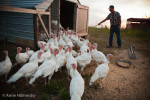Garden Together Now
by Daniel Tucker
3/22/14 Lecture for CCCG
I have a question, for you to consider: What do community gardens do? Rather than stating the obvious, I want to take a circuitous route back in time that can hopefully get us back to this question – a question you all undoubtedly have insights and opinions about that we can all learn from.
Five years ago my collaborators (Amy Francescini and Anne Hamersky) and I took a trip across the US to visit and interview farmers who were engaged in some mix of sustainable food production and social justice activism saying simply “we want the way the food system works to change, so we choose to seek out and meet with people across the country who are doing just that.” The visits required a lot of preparation, such as researching the people I would interview in local news outlet archives, and sometimes calling around to get second opinions from other journalists, activists or farmers that I knew in the area – to see if the faint impressions I had gathered matched to reality. Afterall, I didn’t want to travel across the country if someone was just putting on a good show via their website. Despite my advocacy for them, it is hard to trust self-representations, especially when there is so much to gain from misrepresentation. At every stop I would spend at least half a day with the farmer or organization, and typically carry on side conversations with their collaborators or neighbors to get some sense of their work in context, always asking for clarity beyond what they say they do – to what they really do. Sometimes there were tours, sometimes they put me to work, and very often there were farm-fresh meals with friends and family.
As we explained in the introduction to the book, the various approaches we found “reflect different and sometimes opposing philosophies. Many place themselves within subcultures currently working under banners such as “food justice” “sustainable agriculture” and “local foods movement” [to name a few] and share their philosophies through education and demonstration. For some its through direct action and policy battles, and for others, their physical work and very local distribution is quite enough…For each farm [of the 20 total] we cover essential details: scale, working habits, influences, and organizational structure. We discuss philosophies, public policy, history, soil, and distribution methods. By understanding how these individuals are creating solutions for their lives and the lives of those whom they care about, we feel more optimistic about our future. We present their stories here because we know that a new food system can only emerge if the diversity and complexity that these folks embody are part of the discussion.”
I am going to tell you about three of the people I met along the way, and some of the impressions that they left me with that challenge and inspire me nearly 5 years later.
On one visit, I got to talk with a medicinal herb farmer in the mountains of North Carolina named Joe Hollis. For thirty years Joe had been striving to embody his manifesto of Paradise Gardening and that is what drew me to him – I wanted to include someone in the book that had a handmade ideology that guided their life’s work. Stepping onto Hollis’ land was like entering a fantasy novel, with hand-bent archways, winding pathways and patches of beautiful and unfamiliar plantlife. The architecture was built into the mountain slope and included yurts, A-frames and a central building functioning as a library, lab, pharmacy and outdoor kitchen. Perusing the thousands of books on his shelf, the spectrum impressed me – classics of existentialist, left-wing anarchist and socialist thought mingled with poetry, anthropology, botany, ornamental gardening and guides to all sorts of tools and technology.
Finally he invited me to sit, and we began our interview. After covering some of the basics of his work and land, I asked him to talk about Paradise Gardening. After explaining the fundamentals of minimal money economy, less harm to the earth, and egalitarian human relations – I asked him to address his conception of this practice as a democratic one, that should be accessible to all people. It seemed important to him to be modeling a certain kind of behavior in the world that would communicate to others his value system. I asked him about his approach to “outreach,” knowing that if inviting others in and sharing the work was important to him that he would have something to say on the topic. He then stunned me by explaining that he gets frustrated talking about the work when he could be doing it, essentially saying that every time he sits down with someone like me or gives a tour, “that is that many more minutes that I am not perfecting my life philosophy.” If he was really good at outreach and promotion – he would never get anything done, Hollis explained “I could just do 100 percent my paradise garden, and it would be better than it is. On the other hand, the whole point for me is the outreach, to try to influence people. There is always that back-and-forth.”
It seemed that Hollis had found himself bumping against a problem similar to that of artists, the other universe of people that I sometimes interact with and which I had wondered if it could be possible to connect to this food discussion. Beyond some conception of the isolated genius, his concern with what constituted “the work” and what constituted “the representation of the work” and how they could serve or detract from one another seemed particularly pertinent to both artists and activists who hoped to prefigure the world they wanted while actually doing something – not just making Paradise Garden manifestos or posting pictures online.
Another group I visited on that trip was the Georgia Citizens Coalition Against Hunger, just a four hour drive away in Atlanta but seemingly worlds apart. What drew me initially to the Hunger Coalition was that they had originated as an activist organization – focused entirely on legislative advocacy around policy related to poverty in the 1970s, such as the WIC program that was being grown at the time. They did great work, but as longtime director Sandra Robinson recounted to me, she got a call one time from a young woman asking: “Do you all have any food? I have three children and I need food.” Sandra said, “We don’t have food, but we have some powerful information, and we want to get you involved in helping us change the way the food stamp program is organized.” She said, “Ma’am, I want some food. I don’t want no conversation!” Sandra recalled “I had a real awakening that day. We talked a lot with her. She gave us a real education about the economy, and we helped her get food and apply for food stamps so that she was able to stabilize her situation. This led to more conversations with the public, and it became clear that we needed some kind of program for emergency assistance.”
The Hunger Coalition started a Hunger Hotline in 1988, soon after they opened a food pantry and by the early 1990s they were working with rural African American farmers from the Federation of Southern Cooperatives to sell food at farmers markets in Atlanta’s public housing. Responding yet again to their constituency, the group posed a question to a group of women they had been working with – “what would make you feel more secure during the impending cuts to the welfare system?” The women described a kind of mall with a thrift store and a garden mixed together. They immediately opened the thrift store and Within a few years, they had started their own 2 acre vegetable farm in South Atlanta.
At first they had a pitiful harvest and as they were learning the ropes, they won a grant from the Community Foundation’s Make a Wish fund to allow them to buy a tractor and increase their capacity. At the same time, the same thing that was happening in Chicago with the plan for transformation was happening in Atlanta’s public housing stock. Their constituency was being displaced to far corners of the city and the food-centered culture they had been creating with their markets began to dissipate.
What had attracted me to the Hunger Coalition was their willingness to adapt and reinvent themselves – embracing change over settling into codified habits that wouldn’t serve them or their goals. Another person I met that embodied that openness to reinvention was Jim Knopik.
A third-generation farmer from North Star, a village that no longer exists in central Nebraska, Jim Knopik decided to protest when he found out that some very large “factory farm” meat producers were going to be moving to town and disrupting the local economy, and bringing along their environmentally toxic approaches to food production. In the process of mounting a resistance against the confined-animal feeding operation (CAFO), Knopik realized that his own farm was involved in some practices that were also ecologically unsustainable and were harming the animals and the land. He had lost touch with the values he was raised with.
Knopik reformed his farming and founded North Star Neighbors with his wife, Carolyn, his son, Ron, and a network of four farms in the region. North Star Neighbors is a direct-marketing cooperative specializing in raising beef, pork, lamb, chicken, turkey, and duck. Recently the North Star Neighbors considered closing their doors, and sent out this message on their Facebook page on January 7th, which I will now read an extended quote from:
For this small group of farmers, its time to throw in the towel. The different situations that our families are in at this time just doesn’t give us the time and resources needed to grow and run our business…
We have learned much about our food, our land, our environment, our history and people in our time as a coop. No, we are not perfect but we continue to learn the difference between what is good and bad and what is right and wrong. Our primary goals haven’t been about how much we can raise or how many people we can feed but how our animals were raised and the environmental footprint that we leave behind.
We were not alone in our time. Many of our customers became our good friends and then part of our neighborhood. They have taught us much about living and eating healthy and believing in what we do. We are very grateful for all the support we have had. Many Special Thanks for that.
Where are we going from here? I know our time with North Star Neighbors has changed all of our lives forever. We experienced the importance of working and living together. We know the importance of community. I believe our future as individuals will not forget our past and continue to move toward those ideals we believe in. We still have a large inventory of individual cuts of meat and will still be making deliveries for the next few months. Thank you, All of North Star Neighbors
As it turned out, the North Star Neighbors had a community meeting a few weeks later and were so overwhelmed by their support that they decided not to throw in towel, but to try to reinvent themselves once again.
You might well ask, what do rancher farmers from the plains, paradise gardeners from the mountains and welfare rights activists in the south have to do with community gardening in Chicago, let alone, what do they have to do with each other?
I asked myself this same question when we finished doing all these interviews , thinking – whoa, this seemed like a good idea to bring all this stuff together but once it had been done it seemed they couldn’t be reconciled. What tied them together? If Jim Knopik’s cooperative didn’t change how people in his area got meat, they’d go out of business and stop farming – they had to change the economics and logistics of food distribution, at least on a small scale. Meanwhile, the Hunger Coalition could have bad crops for two years and then get a grant to buy a tractor – operating on a completely different model. Then you have Joe Hollis making tinctures in the woods and selling rare mushrooms to fancy farm-to-table restaurants in Chapel Hill. Its like you have one group that is all grant writing and outreach, one guy stuck in the middle striving for balance, and the other group that is all work all day in an uphill battle against the decline of family farming.
One thing they had in common was the farm bill, for the same subsidies that might support Tobacco farmers in North Carolina to switch to medicinal herbs with Hollis as their teacher would support North Star Neighbors buying a regional refrigeration unit and distribution center for sustainably raised meat. And the WIC and SNAP food stamp programs that the Hunger Coalition organizes around are funded through the same bill (and were significantly cut this year). We could have a whole conference just oriented around this, but I encourage you to look into the 2014 bill where traditional commodities subsidies were cut but still represent disproportionately based on food that is for human consumption. Commodities are receiving $23 billion over 10 years, and funding for fruits and vegetables and organic programs increased by more than 50 percent over the same period, but is still only $3 billion.
Another way to consider what the three examples have in common, is to get back to that initial question, “What do Community Gardens Do?” because that is why we are here. In some ways community gardeners have a lot to do with all three of these examples, and in others your work couldn’t be more different.
A recent report on gardening in Philadelphia defined community gardening as “ places where people from more than one household garden on land they do not own.” With that simple definition in mind, I tried to cull from various writing and consider for myself what were some of the things that community gardens do for the practitioners and the world around the garden . In no particular order, those included:
- Health and therapeutic benefits of gardening and producing nutritious food,
- Recreation and pleasure,
- Reducing family food budgets,
- Transmitting cultural heritage,
- Convene with the natural environment,
- A strategy in building communities: Work Towards Common Goal in Common Space,
- Promote social justice,
- Build personal character and confidence and encouraging self-reliance,
- providing a catalyst for conversations about neighborhood and community development,
- stimulating social interaction across social boundaries,
- beautifying neighborhoods,
- conserving resources,
- education,
- job training,
- Sites to engage with seasonal transformation: observing the constant change and evolution around us.
I want you to consider the diversity found in that list. There is so much going on beyond food and soil. As my collaborators and I sought out on our journey five years ago to see who was changing the food system, we stumbled into an insight. People that make gardens do not change the food system in and of themselves. The way that food circulates in this country and the global division of labor that grows, transports and sells the food is too vastly complex to be trumped even slightly by even our impressive collection of 260 community gardens in Chicago. In order to know what we are doing, we have to talk to each other, but we also need a theory of transformation that we are oriented towards – that can include digging in the dirt by ourselves for nourishment, and fighting for better federal food policy.
What we do is we transform the culture around food, land and community that create the conditions for people like Jim Knopik and the North Star Neighbors to focus their energy on raising animals and growing crops and finding new and better ways to distribute them, rather than worrying about outreach and social media. In the process we keep in mind that our work cannot be exclusive or leave out incredibly poor people getting screwed over by our food policy and wildly uneven distribution of wealth and poverty. So our cultural shift needs to have a redistributive politics that takes seriously listening to the needs and desires of all Chicagoans, just like the folks in the Hunger Coalition managed to do for so long in Atlanta. And we need to be comfortable with the tension between doing and showing that Joe Hollis described to me from his mountain perch, because they are two sides of the same coin … just as gardening for all the reasons I listed earlier, and grappling with the complex economics of the global food system can be two sides of a many-sided die, if we are willing to think through it and work together.




